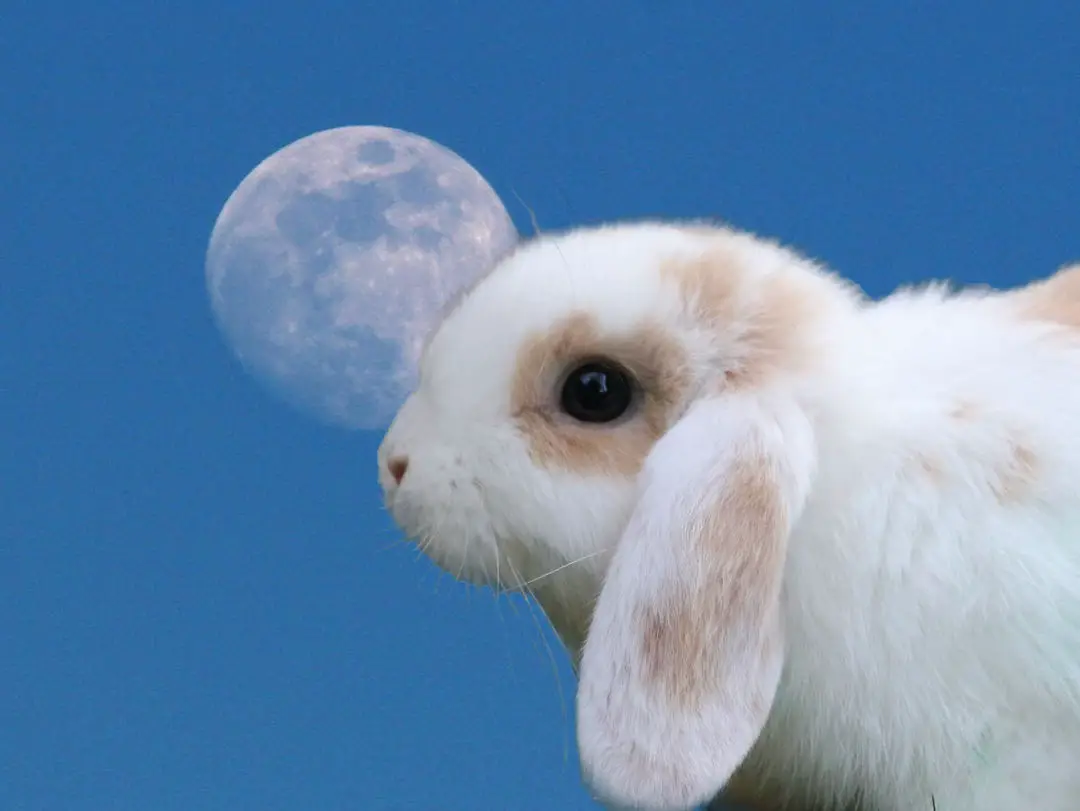Ever wondered when rabbits are most active? Is it at night? Perhaps you’ve a pet bunny (or two or three…) and want to know more, or maybe you’re just interested in finding out more about wild rabbits. Either way, there’s a simple answer to ‘are rabbits nocturnal’, and a more complicated (but interesting!) answer. Next up is the quick, simple answer.
Are rabbits nocturnal?
Rabbits are mainly crepuscular, being active around the times of dawn and dusk. However, some species of rabbits, such as Dice’s Cottontail, are nocturnal, mainly active at night. Additionally, rabbits are adaptable, and in certain habitats may change their active times to avoid predators and give greatest access to food. This means that pet rabbits may be able to adapt to fit the routine of their owner.
What do nocturnal, diurnal and crepuscular mean?
First, some quick definitions.
Nocturnal – being active mainly during the night
Diurnal – being active mainly during daylight
Crepuscular – being active mainly at dawn and dusk
Rabbits are crepuscular
Rabbits prefer being mainly active during dawn and dusk. Bunnies are more likely to have a nap during the middle of the day or the middle of the night (you can find out more about how and when rabbits sleep here).
This is one of the reasons that many people find rabbits make great pets. If you’re out at work during the day (and asleep at night), your bunnies are most active just when you’re around the home to play with them.
How do we know that rabbits are crepuscular? The research
We know that rabbits are crepuscular in a couple of different ways. First of all, there’s a wealth of experience from owners from all over the world. But secondly, we know from science. Scientists have done surveys of wild rabbits, and noted when they’re active and when they’re not.
One example is a study carried out on wild rabbits in Spain (you can find it here). Within a fixed area, scientists counted how many rabbits were active (that is, not in their burrows but in the open air) at different times of the day (and different times of the year, too).
You may wonder how they counted them, whether it was some high-tech satellite thermal imaging device. No. I don’t think there’s enough money in wild rabbit research for fancy technology.
The researchers basically drove slowly (15 kmh, or about 10 mph) 137 separate times along a 13 km (about 8 mile) route in some scrubland in south-west Spain. As they drove, they counted how many rabbits they could see (presumably not the driver doing the counting). At night, they used a powerful spotlight. The drives were conducted four times a day for three days running each time: once at sunrise; once at midday; once at sunset and once at midnight.
Once they had done this, the researchers considered a whole range of different variables that might affect the numbers: time of day; month in year; wind; moonlight; temperature; and so on.
The research showed, for these rabbits in Spain:
Rabbit activity and time of day – research results
- The rabbits were most active at dusk.
- The rabbits were also active at dawn in the summer months, but less so in winter.
- The rabbits were also quite active at night, particularly in winter.
- The rabbits were least active at midday, but were a bit more active in the winter than the summer.
Rabbit activity and other factors – research results
- Rabbits were less active when it was windy.
- Rabbits were more active after it had been raining in the previous days (in the scrubland environment, this is when plants grow).
- Rabbits were more active when the moon was out.
- Rabbits were less active in extreme temperatures (so less active at midday in the summer and dawn in the winter)
So far, so good. And also, this makes sense from thinking about rabbits and their need to survive and thrive. They want to avoid extremes of temperature, just like we do. We don’t like getting too hot or cold, and neither do rabbits (though their version of ‘too cold’ is much colder than ours – check out this article). In particular, rabbits find it difficult to regulate their bodies if it’s too hot, so they avoid the midday sun (though in Britain that’s quite a rare event anyway).
But rabbits need to think about, not just their temperature, but also any predators, including birds of prey.
And rabbits have potentially lots of predators. Some of these predators will be diurnal (around during the daytime) and others will be nocturnal (around during the nighttime). Being active at dawn and dusk is a good trade-off; rabbits have pretty good vision (find out more here), being better able to see in dim light conditions than diurnal predators, but without full night, where nocturnal predators may be able to see better.
But what happens if most of the predators are diurnal, that is, around during the day?
Are rabbits always crepuscular?
Rabbits are not always crepuscular. In some conditions, rabbits are nocturnal after all. They adapt to their circumstances.
A nocturnal rabbit
We know this because of a couple of other scientific studies. One study (find it here) looked at predators and prey in Costa Rica. This study had a bit more technology (they needed it, as they were studying in forests with lots of potential cover rather than fairly open scrubland). The researchers set up cameras in a variety of locations, that were triggered by the animals using an infra-red sensor. In this way, they could see when animals were most active. It was a large study: they found 8 predator species and 16 different prey species.
One of the prey species studied by the researchers was a rabbit – Dice’s Cottontail. This is a smallish (typically about 3lb for an adult), black and brown rabbit native to Costa Rica.
The researchers found that Dice’s Cottontail was nocturnal. Nearly all (96%) of its recorded activity took place at night.
In other words, some species of rabbit are nocturnal. Another example of a nocturnal species (which lives in a similar type of habitat) is the rarest rabbit of all, the Annamite striped rabbit.
Nocturnal rabbits changing to crepuscular
The second study, published in 2021 (find it here), goes back to the rabbits in Spain. In this experiment, researchers moved a group of rabbits from one location to two new one.s The new locations had different predators. Researchers compared the activity patterns (using camera traps) of the three groups.
In their original location, the rabbits were mostly nocturnal, with predators including red foxes and Egyptian mongeese (who are diurnal – mostly around during the day).
In one location (a fenced area where the main predators were mongeese, around during daylight), the rabbits remained nocturnal.
However, in another location (an unfenced area with a variety of predators) the rabbits became mostly active at dawn and dusk (crepuscular).
In other words, the same species of rabbit can be nocturnal in one context, and crepuscular in a different one.
How adaptable are rabbits to different routines?
Although in the wild, rabbits often revert to crepuscular activity, rabbits turn out to be adaptable to a wide range of different daily activity patterns.
Again, scientists have done the work, this time with rabbits in laboratories. The research was carried out in 1991, in this paper: ‘The rabbit: a diurnal or a nocturnal animal?‘.
The researchers tried out four separate conditions:
- ‘Normal’ conditions – an environment with lots of background noise during the time the lab had lights on.
- ‘Sound-isloated’ conditions – an environment where there was no background sound.
- ‘Constant light’ conditions – an environment where a light was constantly on at the same strength.
- ‘Food-restricted’ conditions – food was only available for four hours each day, during the lit period.
The researchers found:
- In the normal conditions the rabbits varied when they were active; some individuals were diurnal, others nocturnal, and others had no preference.
- In the sound-isolated conditions the rabbits became nocturnal.
- In the constant light conditions the rabbits ended up with a daily pattern a bit longer than 24 hours (this is typical of nocturnal animals).
- In the food-restricted conditions, most of the rabbits’ activity was when food was available.
In other words, the routine for rabbits can be set by the external conditions, including when it’s light, how noisy it is, and when there’s food around. Rabbits are adaptable to different routines.
Rabbit owners can relax a bit about routines
The research means that owners don’t have to worry too much about what a rabbit routine should be. Although rabbits may be crepuscular, if you’re only around at a different time of day, they will happily adapt to that. This adaptability makes rabbits flexible pets for owners.
Conclusion
Rabbits are usually crepuscular, but sensibly they will adapt their routines and activity to avoid predators and be around when food is plentiful. This means that some species of rabbit are nocturnal, and in some contexts rabbits may become mainly nocturnal. Pet owners of bunnies may find that their rabbits adapt to the routine that their owner gives them.
You may also like:
Find out more about when and how rabbits sleep
Explore how rabbits see the world
Ever wondered how high bunnies can jump?
Your bunny zooms really fast. But how fast? Find out


